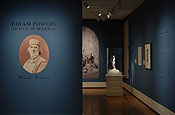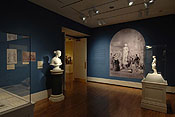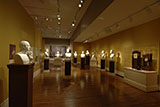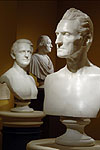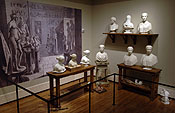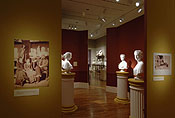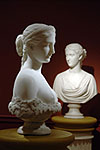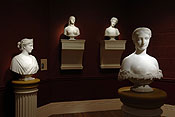X
Please wait for the PDF.
The browser will either open the file, download it, or display a dialog.
The browser will either open the file, download it, or display a dialog.
|
Hiram Powers: Genius in Marble Hiram Powers: Genius in Marble |
|||||
| Cincinnati is deservedly proud of her Artists;… more broad rays of Genius have flashed from the altar there erected to the Graces, than can be boasted of by the proudest city of the New World…Powers alone will immortalize Cincinnati… Cincinnati Daily Gazette 19, no. 5646 (Oct. 1, 1845) |
||||||
| Last summer there was a stunning exhibition of marble and plaster sculpture by the American expatriate to Italy, Hiram Powers (1805-1873), at the Taft Museum of Art, co-curated by Lynne D. Ambrosini, chief curator, and Rebecca A.G. Reynolds, an independent scholar. This was the first major monographic exhibition of the work of America's greatest sculptor of the nineteenth century. Although the title gives no indication of it, the exhibition focused on work that had an association with the Cincinnati, either because it was created there or commissioned by local residents. The Queen City was Powers' adopted hometown after moving there with his family in 1818 at the age of twelve. Powers spent fourteen years in Cincinnati before leaving for two and a half years in Washington, D.C., followed by a permanent move to Florence, Italy. Powers was the first American sculptor to achieve widespread international fame, and the foundation of his renown is The Greek Slave (1834), known by the original plaster and six marble replicas. It was the star of the Crystal Palace exhibition in 1851 and some of the versions toured the United States for years in highly popular, fee-based exhibitions. Powers also became known for his mechanical ingenuity. Impatient with the three-step process of sculpting (clay model, original plaster, marble), he carved directly in plaster, inventing his own tools for the purpose. Others then widely used his inventions. | ||||||
| Because the exhibition had a local focus, it did not travel nationally. Three areas of inquiry received special emphasis: Powers' development and patronage in Cincinnati; his mature work as a Neoclassical portraitist and delineator of allegorical subjects, as seen through his sculpture for patrons in the southwest Ohio region; and the innovative sculptural techniques evident in his extraordinarily refined marble pieces distinguished by tension between idealism and realism. | ||||||
| The exhibition was mounted in five rooms on the second floor of the historic home museum (the Taft Museum of Art was once called Belmont, the home of patron Nicholas Longworth). It featured twenty-five marble busts, eleven plaster works, two Parianware figures, and one pigmented wax and clay piece. Most of these came from Ohio collections, such as the Cincinnati Art Museum, the Toledo Museum of Art, the Dayton Art Institute, and the Taft itself, but also from the Smithsonian American Art Museum. Understandably but lamentably absent were life-size marble figures such as Powers' The Greek Slave (designed 1841-43 and carved in 1870-73, Yale University Art Gallery and other museums) and Eve Disconsolate (also known as Paradise Lost) (modeled 1858/59-60, carved about 1872-77, Cincinnati Art Museum). These works are too fragile and heavy to travel. | ||||||
|
The rooms were painted in colors popular in the nineteenth century, such as federal-period blue and gold or yellow ochre, and also in the cinnamon red that Powers thought would best enhance his sculptures, as he wrote in letters to his friend and patron Nicholas Longworth. The exhibition introduced the viewer to Powers, wearing his studio cap and apron, through an enlargement of an undated, oval albumen print made by his son, Longworth Powers (fig. 1). Below the reproduction was the artist's signature and three quotations proclaiming Powers a genius. This was the word used repeatedly to describe the sculptor, by such writers as Elizabeth Barrett Browning, Henry T. Tuckerman, and C. Edwards Lester; hence, the title of the exhibition. | |||||
|
The first room, "Powers and His Beginnings," featured versions of The Greek Slave, Powers' best known full figure, including a marble bust from the Toledo Museum of Art and a small marble copy of the figure approximately 21 inches tall, ca. 1850-70 (fig. 2). These were displayed in front of a wall mural enlargement of an engraving by R. Thew depicting The Greek Slave in a painting gallery surrounded by viewers, from Cosmopolitan Art Journal 2, no. 1 (Dec., 1857). The circular positioning of these three images, all with their heads turned to the left, was clever. The bust, on the left, even with downcast eyes, seems to look in the direction of the engraving on the back wall where the Greek slave appears to glance at the small figure on the right which, in turn, suggests anticipation of the gallery visitor. It is a pity that a full-size original of The Greek Slave—the star—is missing; one could say that the rest of the display is merely peripheral. Nevertheless, the supporting materials still convey a compelling narrative. | |||||
| In a glass case were two large daguerreotypes of the statue (front and rear views, both 1853, Cincinnati Art Museum) by Abel Fletcher and an engraving from 1874 by Alonzo Chappel of the sculpture, a scrapbook of clippings about the sculpture (1847-49) compiled by Powers' daughter Louisa, and various publications about the piece, including two pamphlets by Miner Kellogg (who served as agent for the national tour), Powers' Statue of the Greek Slave (1848) and Vindication of Hiram Powers' in the "Greek Slave" Controversy (1849), as well as Justice to Hiram Powers, Addressed to the Citizens of New Orleans (1848). (These are listed in the checklist to the exhibition but not in the bibliography of the catalogue. Apparently, in order to save costs on the catalogue, the institution decided to list in the bibliography only publications that the authors cited at least three times in their essays; others mentioned just once or twice in footnotes were left out of the bibliography—an odd and unfortunate editorial choice.) On another wall was an albumen print (ca. 1880-1900) of The Greek Slave from the Cincinnati Art Museum. (The date of this was not provided on the wall label but was in the catalogue.) One of the most interesting elements in this section of the exhibition was an enlargement of the outlines of sarcognomy (1854), reproduced from Charles Colbert's book, A Measure of Perfection: Phrenology and the Fine Arts in America (1997). Professor J. Rhodes Buchanan coined the term "sarcognomy" in the 1840s to denote a therapeutic science of the relationship between body and brain, believing that the evolving, cutaneous surface not only possesses a physiological characteristic but also psychological powers. The sculptor was fascinated by phrenology as well, and took exact measurements of his sitters, whom he almost always modeled from life, and never from daguerreotypes or photographs. As celebrated as The Greek Slave was, it was also the subject of heated controversy because of its nudity, despite the fact the Powers tried to mitigate such concern in advance by positioning the slave's left hand in front of her pubic area. Critical remarks about the sculpture's relative immorality abounded, and one wall label featured scathing remarks from the New York Mirror (1845), Fraser's Magazine (1851), The Crayon (1859), the Edinburgh Political and Literary Journal (1851), and the Encyclopedia of Comedy (1899). | ||||||
|
The large second room, with gold walls, was divided into two overlapping spaces (fig. 3). [ill. # 16] The first section, "Almost a Buckeye," traced Powers' roots in Ohio (the buckeye is the state tree), where he moved with his family at the age of twelve. In a wall-mounted case near the entrance on the right were a sketch attributed to Miner Kellogg, one of Powers' lifelong friends, of the simple log cabin that was Powers' first residence in the state (ca. 1830) and a large French book on anatomy (a translation of Sarlandière's Systematized Anatomy from 1835), inscribed to Powers by book dealers. These men were Cincinnati supporters who gave the sculptor the useful publication on the eve of his departure for the east coast in 1836. On the adjoining wall was a reproduction of an engraving (n.d.) of the young Powers in profile by Pierre Jean Edmonds Castan (after Peyton Symmes), and a titillating broadside attributed to Powers, printed in ink and watercolor, advertising the "Infernal Regions" (1832) at the Western Museum where Powers had created automated figures for sensational displays. Powers' work for the Luman Watson Clock Company, where he improved machinery for cutting clock wheels and simplified a design to produce more accurate wooden clockworks, is referenced in the exhibition with a case containing a Groaner shelf clock (about 1825), a closed city directory (1829) with a reproduction for an advertisement for the Luman Watson Clock Company beside it, wood-movement clockworks for the Groaner, and a hollow-column shelf clock. | |||||
| The other half of this room, titled "Seizing a Likeness," displays a reproduction of Nicholas Longworth's residence from Harper's Weekly (1858). Lawyer, landowner, and vintner, Longworth was one of Powers' most important patrons, and lived in the Baum-Longworth-Sinton-Taft House, which became the Taft Museum of Art in 1932. In a case were the earliest examples of Powers' sculpture, including a wax and clay head of artist, Miner Kilbourne Kellogg (1828), and two plaster pieces, a head of the child Catherine (Kitty) Amelia Foote (modeled about 1828) and a death mask (1838) of Powers' first child, James Gibson Powers, who passed away at the age of four. There was also an oval daguerreotype (1857) of the bust of Ginevra by William Southgate Porter. This reproduction might have been better placed in a subsequent room where two busts of Ginevra were displayed. On the wall was a photograph of the interior foyer of the Bishop House before 1924, where the original plaster bust of the Reverend Dr. Robert Hamilton Bishop (1834) once rested. | ||||||
|
The overlapping area between the two sections of this large room featured eleven busts on pedestals, mostly of distinguished male leaders; five of them were on black columns, four on brown plinths, and a plaster in a case was on a white base. The variety of pedestals and varying pedestal heights, although somewhat unusual in museum exhibitions, helped with the flow of the show. The curators did extensive research into the type of pedestals that Powers used for his work, which varied depending on the subject and style of any given bust's truncation. Although Powers preferred certain heights, the exhibition designer, Mark Rohling, brought them down slightly for the museum setting. One of the most enjoyable aspects here was the fact that three marble busts were placed in the middle of the gallery with ample room to view the pieces in the round, as Powers would have desired. First is the bust of jurist, statesman, and diplomat Alphonso Taft (modeled 1869, carved 1869-70) which is supplemented by the original plaster and working model of Taft close to a wall nearby. The second portrait bust, Judge Jacob Burnet (modeled 1837, carved 1842), from the University of Cincinnati, is superb masterpiece of naturalism with its wrinkles, moles, sagging skin, thin, set lips, and tense throat muscles (fig. 4). It is a true likeness of the imposing judge known as "The Black Hornet." Finally, there is a bust of Powers' wife, Elizabeth Gibson Powers (modeled about 1859, cast and finished after 1859). As was the case with the daguerreotype of Ginevra, it might have made more sense if the carte-de-visite of Elizabeth Powers was displayed in closer proximity to the bust, but it might have been awkward to mount a wall case just for this small image. As a compromise, the curators placed a reproduction of a period photograph of Elizabeth Powers on the plaster's label. Object labels make the Cincinnati connections to Powers clear. Powers modeled the bust of Burnet from life in Cincinnati and carved it later in Florence; Powers met his wife in Cincinnati; and Taft was the father-in-law of Anna Sinton who later lived in Longworth's home. | |||||
| Other portraits on display were those of Ohio's first millionaire, Nicholas Longworth (modeled 1834 and 1849, carved 1849-50), George Washington (modeled 1838-44, carved 1859), Benjamin Franklin (modeled 1848-51, carved between 1851 and 1873), state legislator and member of the U.S. House of Representatives Robert Todd Lytle (modeled 1835 and 1849, carved 1850), banker James Gilmore (1865), wife of the minister to the German Empire, Alice Key Pendleton (1870), and U.S. Chargé d'Affairs to Sardinia, Robert Wickliffe, Jr. (modeled about 1847, carved 1857). Again, wall texts and labels reveal ties to the Cincinnati area. The Young Men's Mercantile Library Association of Cincinnati requested a purchase from Powers' studio that was suitable to the character of the institution, and the sculptor suggested the bust of Washington; he had executed at least twenty-five such works because of popular demand. Similarly, he made over fourteen portraits of Franklin, and a local physician bought one of them. Acquaintances from Cincinnati, Lytle and Powers became close friends when they were working in Washington, D.C. Gilmore also knew Powers in the Queen City, and visited him in Florence, where he sat for his portrait. Pendleton's husband was only a child when Powers left for Italy; this was a rare instance when Powers likely created a bust without a live model. Wickliffe hailed from Lexington, Kentucky and developed a close relationship with the sculptor in Florence. Of special note on the labels was the identification of carvers from Powers' studio; much of this was the result of new research. Scholar Richard Wunder had already established those names over thirty years ago, but it is unusual to credit the carvers along with the "genius." Visitors could use the knowledge to compare work by Powers' two master carvers. Powers had assistants who specialized in hair, beards, etc. | ||||||
| The curators included extra visual materials to provide context for the sculptures. Near the bust of Lytle was a photograph of the work in a hallway of the Lytle Mansion (1903) where it stood for many years. Next to the bust of John Quincy Adams was an undated copy of a poem by Adams (1837) in praise of Powers, written in an unknown hand. One measure of Powers' immense popularity during this time was a steamboat named after him (1848-53), featured on the wall in a reproduction of a color lithograph by Henry Lewis from Das Illustrirte Mississippithal (Düsseldorf, 1854-57). There had also been a steamboat named The Greek Slave (1849-57)! | ||||||
|
Perhaps the most thought-provoking room (actually, the back portion of the second space) was the recreation of "The Sculptor's Studio," against a taupe background (fig. 5). On the back wall was an enlarged illustration of Powers' Florence studio interior from Harper's Weekly (1873), misidentified on a wall label as a photo enlargement. At the rear of the image is a tent showing the smithy where Powers produced his own sculptural tools. In front of this "mural" was an actual table featuring three busts of The Greek Slave (a plaster from 1846 that retains metal-plug work points and seam lines of the mold), and marbles from 1848 and 1858, the original plaster and working model of Anna B. Sinton (modeled 1870) on a stand by itself in the corner, two busts on a table to the right (two versions of Portrait of a Lady, one in plaster and one in marble, both 1860), and three busts on a shelf mounted on the wall above (a plaster of Fisher Boy, a marble of Paradise Lost or Eve Disconsolate, and a plaster and working model bust of a Alma Hammond L'Hommedieu, the oldest living member of Christ Church in Cincinnati, modeled about 1871). Just as in the engraving, one of the pieces on the shelf was turned to the wall, a brilliant touch. This was Paradise Lost, best seen from behind to showcase Eve's gently twisted locks. | |||||
| On the lower shelves of the tables and the floor were modern sculptor's tools, such as a pointing machine, heavy mallets, coarse chisels, rasps, files, pumice, an armature for building up clay portraits, and a mold for casting plaster, loaned by five studios, four of which are in Massachusetts: Skylight Studios, master carver Reno Pisano, Margaret Cassidy Manship (daughter-in-law of sculptor Paul Manship), and the late Walker Hancock. Although these items are mostly contemporary, such tools have changed little over the last century. Their inclusion certainly enhanced the studio environment. To the right of the table and shelf was a reproduction of a demonstration of sculptors working taken from a page of Francesco Carradori's Elementary Instructions for Students of Sculpture. Unfortunately, the original date of this publication—1802—was not given; the tag line read that this came from the J. Paul Getty Museum in 2002, the year of the book's reprint. On a modeling stand in the corner was the original plaster and working model bust of Anna B. Sinton that had been painted posthumously by an unknown hand. Sculptor, collector, and independent scholar Theodore Gantz, who found the piece in a flea market, gave it to the museum, which conserved the piece. Beside the bust was a photograph of the piece the way it looked before cleaning. | ||||||
| To the left of this recreation were displays of additional sculptor's tools as well as more personal mementos from Powers' family. In addition to an original note of payment for the bust of Taft from January of 1870, there were fifteen of Powers' tools. A nearby reproduction of an undated photograph by the Alinari brothers shows marble quarrying in Carrara, the source of most of Powers' high-quality marble, "pure, immortal, and discreetly sensuous," as described by the curators on the label. Another photographic reproduction presents Powers' family sitting in front of his studio in their Florence residence (1856). In a case beside this was a mold for a positive cast of a child's hand (1851), the first cast of daughter Luly's hands (1839), a marble version of this most famous hand sculpture by an American artist in the Victorian era (between 1839 and 1844), Powers' studio cap, and a plaster cast of Powers' right hand and wrist. Such poignant and personal items added a touching element to the display. Nearby was a reproduction of an unidentified type of photograph from the Cincinnati Art Museum of showing a studio, possibly that of Longworth Powers. | ||||||
| The fourth room, called "Ideal Subjects, or Fancy Parlor Pieces," was a small octagonal space with two doorways, featuring seven marble pieces against cinnamon red walls (fig. 6). Five busts were placed atop fluted columns that were slightly distracting with their white centers but gold tops and bottoms. As one entered the gallery, to the left were Ginevra (1839-1841) and Psyche (1851-53). To the right were Ginevra (a second version, created by 1873), Proserpine (1844), and Charity (modeled 1867-71, carved 1871) (fig.7). I would have preferred to have seen four depictions of Ginevra side by side—the two busts along with the daguerreotype of the bust from the first room and a carte-de-visite from the last room—so that I could compare and contrast all three images and more closely observe the changes that Powers made to hair and clothing. One could argue, however, that Powers was less interested in the actual subjects of his works than the formal qualities, and that the two were explorations of form rather than a mythological character. To avoid the "ring around the bathtub" type of installation, two busts were mounted on small shelves well above the works on pedestals. These were Paradise Lost (1859-62; carved 1873, Dayton Art Institute) and Fisher Boy (1849-1870); both featured nearby photographic reproductions of the full figures (fig. 8). It was a pity that these pieces were so high; Powers would have wanted them to be seen at eye level. He usually specified the proper way to display his busts, recommending that single light be placed so that the shadow of the nose stops at the upper lip (35). All of the other pieces (save those in the recreated studio) were displayed according to this specification, and masterfully lit by Mark Allen. Once more, labels explained the Cincinnati connections of these pieces, except for Fisher Boy and Paradise Lost, although the full figure of the latter is in the Cincinnati Art Museum. The first public exhibition of Ginevra took place in Longworth's home. Director of the Western Art-Union, Cincinnatian Charles Stetson, ordered the bust of Psyche as a gift for his wife. Other local civic leaders bought the sculptor's work, too. Reuben Springer commissioned Proserpine, Powers' most popular piece, from the artist. And entrepreneur, Henry Probasco, who owned the city's largest hardware business, requested a new bust of Charity while visiting Powers' studio abroad. | ||||||
| In the last room, a small space painted gold, the "Epilogue" featured four works representative of Powers' career and the end of his life. This included an enlargement of a drawing or engraving (medium not identified) from Harper's Weekly (1873) depicting the late Powers and his melancholic wife, who always longed to return to her native Cincinnati, leaning on a windowsill in Florence. In a nearby case were three stereographic views of busts of Mrs. Powers and George Washington (both 1870) and a tomb of Elizabeth Barrett Browning, all by the Powers Frères. Also in the case were Parianware reproductions of The Greek Slave, a larger one from 1848-1900 and a smaller one dating between 1849 and 1930. Additionally, there were three cartes-des-visite, all by Powers' son, Longworth Powers (all ca. 1868): one of Powers, one of Ginevra, and one turned over to show the back stamp of L. Powers/ Villino Powers/ Porta Romana/ Firenze. There was also a 1934 exhibition catalogue from the Cincinnati Art Museum, from a show that displayed work by both Powers and painter Joseph Oriel Eaton. While these items do not work together effectively to tell a story (the connection between Browning and Powers is not made clear, for instance), they are all interesting pieces of material culture. | ||||||
| On the left wall was a reproduction of a photograph (type and date not identified) of Longworth Powers with a photography cart. Also on view was a small reproduction (1865) of The Greek Slave in a glass bell jar, the kind statue that would have been proudly displayed in a Victorian parlor. There was an original plaster working model of a bust of Charlotte Frances Frederica Seymour, Countess Spencer (1859), an ancestor of Princess Diana. The entire piece was later painted in imitation of variegated marble to suit changing tastes; the current local owner, Theodore Gantz has left it in that state. This was a nice complement to the bust of Anna Sinton, which had been painted in a similar fashion and also discovered by Gantz, but the piece has no historical Cincinnati ties. As in the case of the four images of Ginevra scattered throughout the exhibition, it was a shame that the plaster and the marble of Anna Sinton were separated; this would have been a rare opportunity to compare the two side by side. The curators might have tucked it away in a less prominent position in the studio environment because, although it has been conserved, it seemed as though it were coated with a protective layer of shellac which somewhat marred the original beauty of the plaster. Also, it appears that the pointing nails were removed. If left intact, this bust would have been a better teaching tool about the process of sculpting. Also in this room was a photograph of that plaster of Anna Sinton, near the marble busts of Sinton and her father David (both carved by Antonio Ambuchi in 1872), who had sat for Powers in while on a Grand Tour of Europe in 1870. Anna's bust sat atop a pink column, the only original pedestal in the exhibition. David's herme-style bust rested on a suitable tapered pedestal owned by the Taft. | ||||||
| In conclusion, despite a few quibbles about the separation of versions of the same works of art, the placement of two busts too high, and some missing dates and information about photographs on labels, this was a beautifully conceived and executed exhibition. It was especially noteworthy since there are relatively few shows on nineteenth-century sculpture because of the fragility and weight of larger works, and the often prohibitive costs of shipping and installation. | ||||||
| The full-color exhibition catalogue, Hiram Powers:Genius in Marble features essays by the co-curators. Lynne Ambrosini's masterful essay, ""Pure, White Radiance": The Ideology of Marble in the Nineteenth Century," is a lyrically written and very insightful discussion of the preference for white marble in nineteenth-century sculpture. Ambrosini argues persuasively that marble was the privileged material of sculptors for nearly three quarters of a century, in the United States especially, for three reasons—it was the model provided by antique statuary, it connoted immortality, and artists praised its unmarred perfection. To underscore her points, Ambrosini (and co-curator, Rebecca Reynolds) combed nineteenth-century publications, documenting her pioneering scholarship with 203 careful footnotes. For instance, in a Cosmopolitan Art Journal from 1860, Ambrosini found a comment by Julia Layton about the loss of surface detail in marble sculptures at Greenwood Cemetery in Brooklyn. Layton suggested that bronze, then, should be the "aesthetic type of immortality" rather than marble (15). As Ambrosini noted, Layton's recommendation was one of the isolated voices amid a chorus of acclaim for "undying marble." With clear subheadings, Ambrosini explores marble's Grecian prestige in terms of Johann Joachim Winckelmann's advocacy, the quest for (and impossibility of finding) top grade marble in the United States, the paradoxical associations of marble with both death and immortality (with an exploration of the once-ubiquitous phrases "marble immortality" and "living marble"), marble idealism and white purity, the nude in marble, and tensions and complications in impure marble. In this last section about the veiled and explicit eroticism of sculptural female nudes, Ambrosini notes that: "Marble sculpture's purity was a tease" (21). | ||||||
| Reynolds' essay, ""Almost a Buckeye": Hiram Powers and Cincinnati, His Adopted Hometown," is a well-researched and amply footnoted exploration of Powers' Cincinnati ties that corrects earlier erroneous assertions. It is slightly marred by sloppy editing. For instance, lightning is misspelled as lightening, the passive voice is present in "a fashionable carriage was driven by a skeleton" (32), and the incorrect phrase "off of" is present (33). Reynolds also penned an informative four-paragraph entry on "Hiram Powers's Sculptural Process," a brief but accurate chronology (Powers' early years in Cincinnati had been confused in other accounts); and detailed catalogue entries on forty-two works by Powers. Because one of the goals of the exhibition was to examine Powers' innovative sculptural techniques, that section could have been expanded. Also, since the focus of the show was on Powers' connections to Cincinnati, it would have been logical to begin the catalogue with Reynolds' essay on this topic rather than Ambrosini's more general examination of the ideology of marble, which could have been a feature of a number of catalogues on nineteenth-century sculpture. However, Ambrosini is the senior scholar and she was the driving force behind the exhibition. | ||||||
| Although reproductions of the full figures of Fisher Boy and Paradise Lost (originals not in the exhibition), as well as images of the busts and copies of The Greek Slave are included here, surprisingly, there is no reproduction of an original full figure of The Greek Slave, the central piece around which the show is organized. Neither are there reproductions of the stereographs featured in the show, of the busts of Elizabeth Powers and George Washington and the tomb of Elizabeth Barrett Browning. However, there is a reproduction of something not in the show. The frontispiece to Reynolds' essay is a photo gallery (forty-eight images, possibly albumen prints) of Powers' sculpture and Powers himself by Longworth Powers, depicting pieces such as Prosperine, The Greek Slave, Faith, Hope, Charity, California, Clylie, Ginevra, America, and Diana from various angles. This could have been an enhancement to the exhibition. | ||||||
| As a whole, the publication is valuable as the first major exhibition catalogue on Powers. However, its physical appearance is disappointingly cramped. The margins are about half an inch and the font is ten-point. There are no full-page plates (except, curiously, the image of Powers and his wife at the window from Harper's Weekly), and there is little space surrounding the beautifully photographed sculpture. Further, the paper is glossy but not high quality. It was probably an institutional and financial decision to produce such a slim volume about the size of a magazine, but the length of the text demanded more room. Such a tight-fisted treatment is a disservice to the scholarship, the exhibition, and the sculpture itself. Further, production problems meant that the study was not ready in time for the opening; it only became available when the show was almost two-thirds through its run. Nevertheless, the catalogue is an important contribution to the literature on Powers, complementing and updating Richard Wunder's exhaustive monograph (1974) and Donald Reynolds' dissertation on Powers' ideal sculpture (1977). The publication is also certainly an enhancement of our understanding of nineteenth-century American sculpture. | ||||||
| Theresa Leininger-Miller Associate Professor, Art History University of Cincinnati theresa.leininger[at]uc.edu |
||||||


